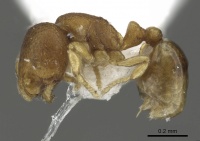Carebara nuda
| Carebara nuda | |
|---|---|

| |
| Scientific classification | |
| Kingdom: | Animalia |
| Phylum: | Arthropoda |
| Class: | Insecta |
| Order: | Hymenoptera |
| Family: | Formicidae |
| Subfamily: | Myrmicinae |
| Tribe: | Crematogastrini |
| Genus: | Carebara |
| Species: | C. nuda |
| Binomial name | |
| Carebara nuda Fernández, 2004 | |
Nothing is known about the biology of Carebara nuda.
Identification
Fernández (2004) - A member of the Carebara escherichi species complex. This is the only known American Carebara of the escherichi group totally devoid of long hairs on body. There is little pubescense, limited to just a few areas.
Keys including this Species
Distribution
Latitudinal Distribution Pattern
Latitudinal Range: -27.1833° to -27.18333333°.
| North Temperate |
North Subtropical |
Tropical | South Subtropical |
South Temperate |
- Source: AntMaps
Distribution based on Regional Taxon Lists
Neotropical Region: Brazil (type locality).
Distribution based on AntMaps
Distribution based on AntWeb specimens
Check data from AntWeb
Countries Occupied
| Number of countries occupied by this species based on AntWiki Regional Taxon Lists. In general, fewer countries occupied indicates a narrower range, while more countries indicates a more widespread species. |

|
Estimated Abundance
| Relative abundance based on number of AntMaps records per species (this species within the purple bar). Fewer records (to the left) indicates a less abundant/encountered species while more records (to the right) indicates more abundant/encountered species. |

|
Biology
Castes
Nomenclature
The following information is derived from Barry Bolton's Online Catalogue of the Ants of the World.
- nuda. Carebara nuda Fernández, 2004a: 231, figs. 8I, 11 (w.) BRAZIL (Santa Catarina).
- Type-material: holotype worker, 22 paratype workers.
- Type-locality: holotype Brazil: Nueva Teutonia, 27°11’S, 52°23’W, 300-500 m., xii.1957, no. 194 (F. Plaumann); paratypes with same data.
- Type-depositories: MZSP (holotype); BMNH, CPDC, IAVH, IMLT, JTLC, LACM, MCZC, MIZA, MZSP, PSWC, USNM, WEMC (paratypes).
- [Note: paratypes are also recorded in UNCB, an abbreviation not listed by Fernández, 2004a: 194.]
- Distribution: Brazil.
Unless otherwise noted the text for the remainder of this section is reported from the publication that includes the original description.
Description
Worker
Holotype: HW 0.29; HL 0.38; SL 0.19; PW 0.21; WL 0.28; GL 0.38; TL 1.25; CI 77; SI 66.
Median portion of clypeus longitudinally bicarinate, the carinae diverging strongly anteriorly. A longitudinal and less narrow stripe. Eyes reduced to 1 ommatidium. Propodeal spiracle lower near and above bullae of metapleural gland. Dorsum of head densely sculptured with shallow foveolated punctures whose diameters are greater than the spaces separating them; dorsum of promesonotum and sloping face of propodeum densely reticulated. Dorsum of head with short curved pubescence (more towards borders), less on legs, a little on anterior margin of pronotum; absent on mesosoma and gaster. Long hairs absent on the body. A very few short hairs on petiole, postpetiole and gaster. Yellow brown.
Type Material
Holotype worker. BRAZIL. Nueva Teutonia, 27°11’S 52°23’W, 300-500 m, dic 1957, F. Plaumann No. 194, deposited in Museu de Zoologia da Universidade de Sao Paulo. Paratypes. 22 workers, same data as type, deposited in The Natural History Museum, Laboratório de Mirmecologia CEPEC / CPDC, William and Emma Mackay Collection, Humboldt Institute, IML (collection uncertain), John T. Longino Collection, Los Angeles County Museum of Natural History, Museum of Comparative Zoology, Instituto de Zoologia Agricola, Museu de Zoologia da Universidade de Sao Paulo, Philip S. Ward Collection, Universidad Nacional de Colombia and National Museum of Natural History.
References
- Cantone S. 2018. Winged Ants, The queen. Dichotomous key to genera of winged female ants in the World. The Wings of Ants: morphological and systematic relationships (self-published).
- Fernández, F. 2004a. The American species of the myrmicine ant genus Carebara Westwood (Hymentoptera: Formicidae). Caldasia. 26(1):191-238. (page 231, figs. 8I, 11 worker described)
- Heterick, B.E. 2021. A guide to the ants of Western Australia. Part I: Systematics. Records of the Western Australian Museum, Supplement 86, 1-245 (doi:10.18195/issn.0313-122x.86.2021.001-245).
- Heterick, B.E. 2022. A guide to the ants of Western Australia. Part II: Distribution and biology. Records of the Western Australian Museum, supplement 86: 247-510 (doi:10.18195/issn.0313-122x.86.2022.247-510).
References based on Global Ant Biodiversity Informatics
- Ulyssea M. A., C. R. F. Brandao. 2013. Catalogue of Dacetini and Solenopsidini ant type specimens (Hymenoptera, Formicidae, Myrmicinae) deposited in the Museu de Zoologia da Universidade de Sao Paulo, Brazil. Papies Avulsos de Zoologia 53(14): 187-209.
- Ulyssea M.A., C. E. Cereto, F. B. Rosumek, R. R. Silva, and B. C. Lopes. 2011. Updated list of ant species (Hymenoptera, Formicidae) recorded in Santa Catarina State, southern Brazil, with a discussion of research advances and priorities. Revista Brasileira de Entomologia 55(4): 603-611.

